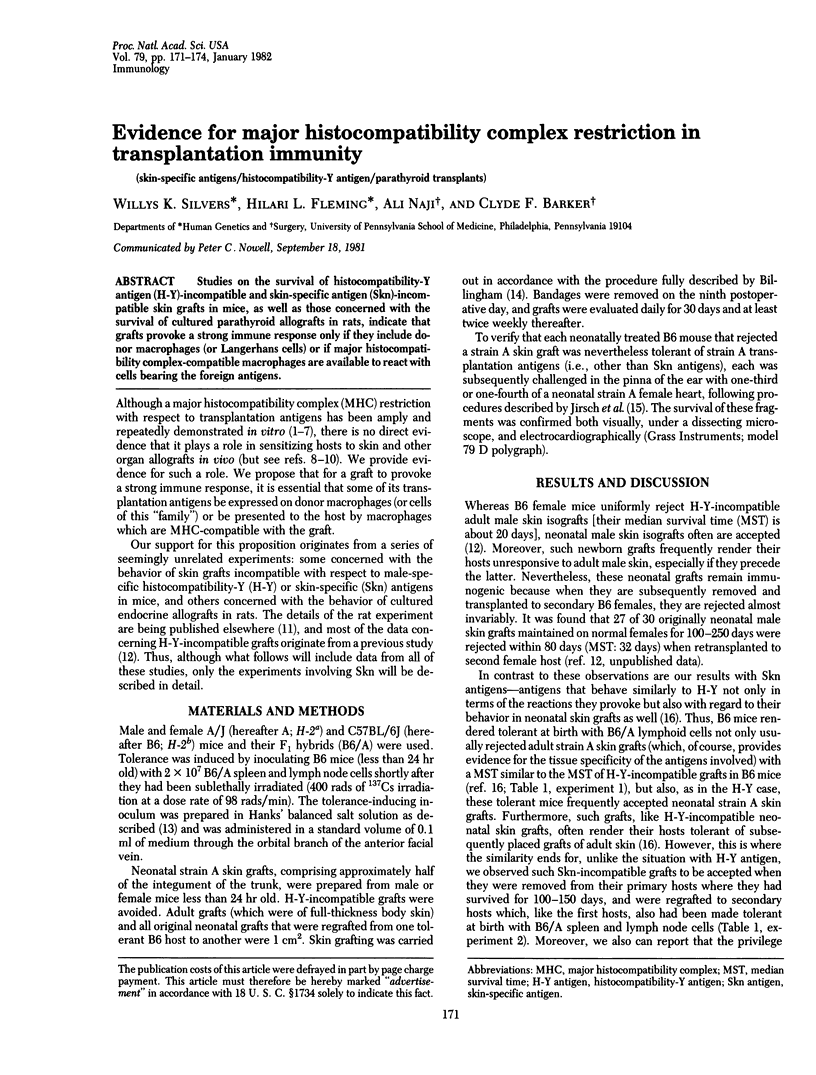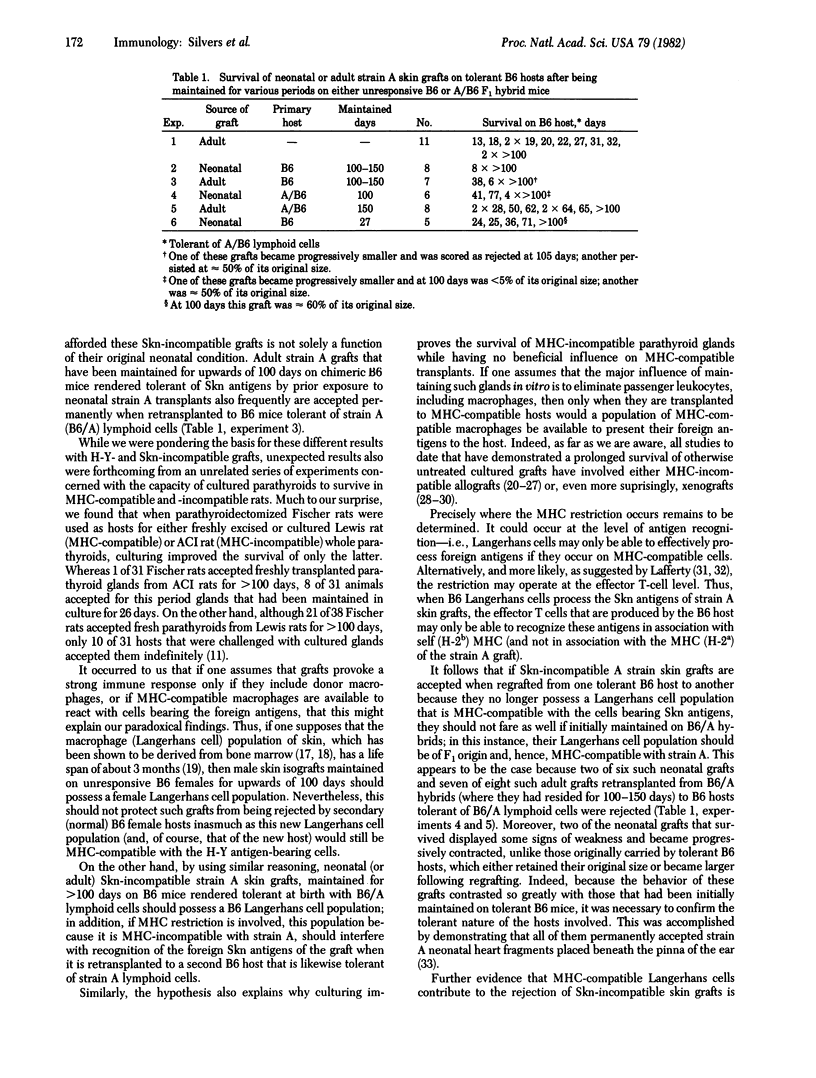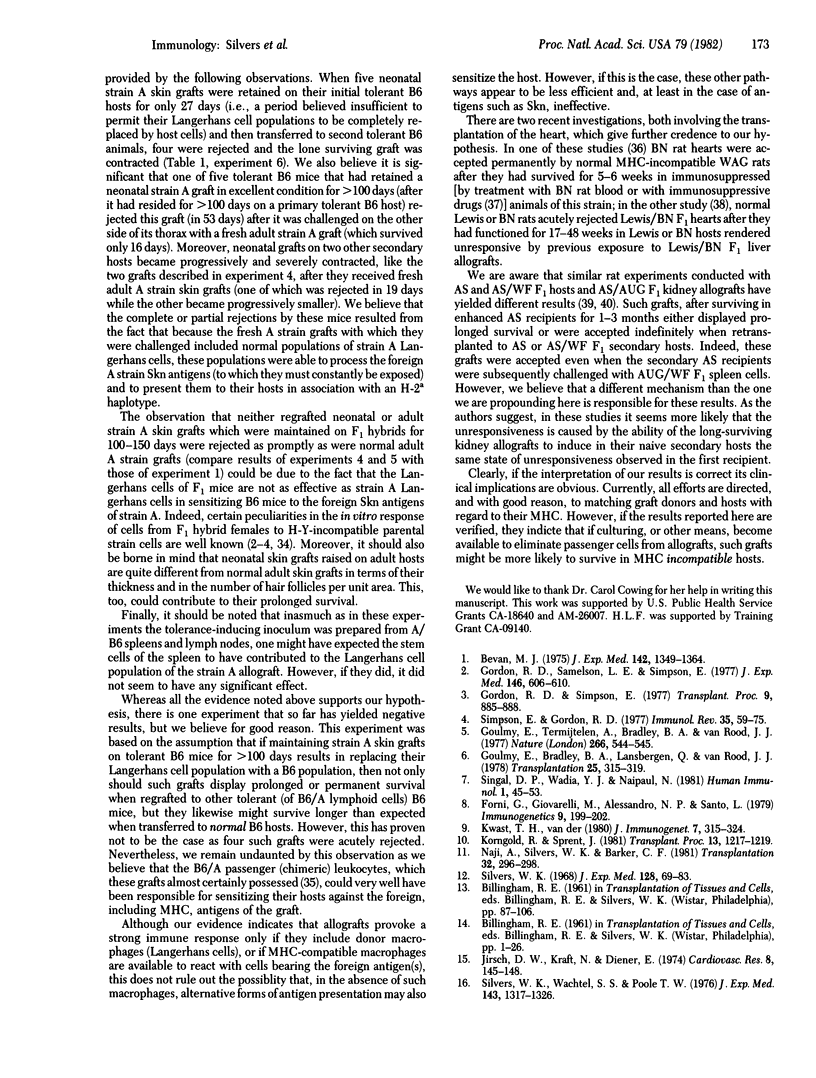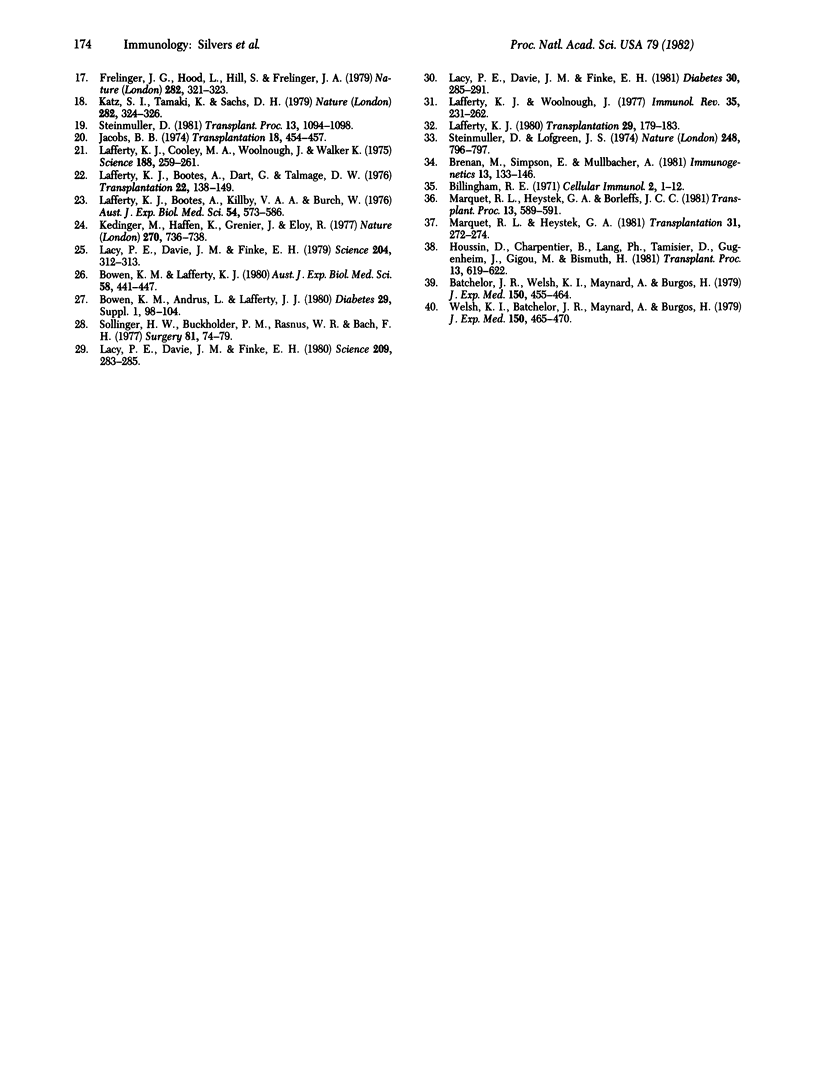Abstract
Studies on the survival of histocompatibility-Y antigen (H-Y)-incompatible and skin-specific antigen (Skn)-incompatible skin grafts in mice, as well as those concerned with the survival of cultured parathyroid allografts in rats, indicate that grafts provoke a strong immune response only if they include donor macrophages (or Langerhans cells) or if major histocompatibility complex-compatible macrophages are available to react with cells bearing the foreign antigens.
Full text
PDF



Selected References
These references are in PubMed. This may not be the complete list of references from this article.
- Batchelor J. R., Welsh K. I., Maynard A., Burgos H. Failure of long surviving, passively enhanced kidney allografts to provoke T-dependent alloimmunity. I. Retransplantation of (AS X AUG)F1 kidneys into secondary AS recipients. J Exp Med. 1979 Sep 19;150(3):455–464. doi: 10.1084/jem.150.3.455. [DOI] [PMC free article] [PubMed] [Google Scholar]
- Bevan M. J. The major histocompatibility complex determines susceptibility to cytotoxic T cells directed against minor histocompatibility antigens. J Exp Med. 1975 Dec 1;142(6):1349–1364. doi: 10.1084/jem.142.6.1349. [DOI] [PMC free article] [PubMed] [Google Scholar]
- Billingham R. E. The passenger cell concept in transplantation immunology. Cell Immunol. 1971 Feb;2(1):1–12. doi: 10.1016/0008-8749(71)90022-0. [DOI] [PubMed] [Google Scholar]
- Bowen K. M., Andrus L., Lafferty K. J. Successful allotransplantation of mouse pancreatic islets to nonimmunosuppressed recipients. Diabetes. 1980;29 (Suppl 1):98–104. doi: 10.2337/diab.29.1.s98. [DOI] [PubMed] [Google Scholar]
- Bowen K. M., Lafferty K. J. Reversal of diabetes by allogenic islet transplantation without immunosuppression. Aust J Exp Biol Med Sci. 1980 Oct;58(5):441–447. doi: 10.1038/icb.1980.45. [DOI] [PubMed] [Google Scholar]
- Brenan M., Simpson E., Müllbacher A. Analysis of haplotype preference in the cytotoxic T-cell response to H-Y. Immunogenetics. 1981;13(1-2):133–146. doi: 10.1007/BF00524611. [DOI] [PubMed] [Google Scholar]
- Frelinger J. G., Hood L., Hill S., Frelinger J. A. Mouse epidermal Ia molecules have a bone marrow origin. Nature. 1979 Nov 15;282(5736):321–323. doi: 10.1038/282321a0. [DOI] [PubMed] [Google Scholar]
- Gordon R. D., Samelson L. E., Simpson E. Selective response to H-Y antigen by F1 female mice sensitized to F1 male cells. J Exp Med. 1977 Aug 1;146(2):606–610. doi: 10.1084/jem.146.2.606. [DOI] [PMC free article] [PubMed] [Google Scholar]
- Gordon R. D., Simpson E. Immune-response gene control of cytotoxic T-cell responses to H-Y. Transplant Proc. 1977 Mar;9(1):885–888. [PubMed] [Google Scholar]
- Goulmy E., Bradley B. A., Lansbergen Q., van Rood J. J. The importance of H-Y incompatibility in human organ transplantation. Transplantation. 1978 Jun;25(6):315–319. doi: 10.1097/00007890-197806000-00007. [DOI] [PubMed] [Google Scholar]
- Goulmy E., Termijtelen A., Bradley B. A., van Rood J. J. Y-antigen killing by T cells of women is restricted by HLA. Nature. 1977 Apr 7;266(5602):544–545. doi: 10.1038/266544a0. [DOI] [PubMed] [Google Scholar]
- Houssin D., Charpentier B., Lang P., Tamisier D., Gugenheim J., Gigou M., Bismuth H. In vivo and in vitro correlates of the specific transplantation tolerance induced by spontaneously tolerated liver allografts in inbred strains of rats. Transplant Proc. 1981 Mar;13(1 Pt 1):619–622. [PubMed] [Google Scholar]
- Jacobs B. B. Ovarian allograft survival. Prolongation after passage in vitro. Transplantation. 1974 Nov;18(5):454–457. doi: 10.1097/00007890-197411000-00012. [DOI] [PubMed] [Google Scholar]
- Jirsch D. W., Kraft N., Diener E. Transplantation of the mouse heart--a useful research model. Cardiovasc Res. 1974 Jan;8(1):145–148. doi: 10.1093/cvr/8.1.145. [DOI] [PubMed] [Google Scholar]
- Katz S. I., Tamaki K., Sachs D. H. Epidermal Langerhans cells are derived from cells originating in bone marrow. Nature. 1979 Nov 15;282(5736):324–326. doi: 10.1038/282324a0. [DOI] [PubMed] [Google Scholar]
- Kedinger M., Haffen K., Grenier J., Eloy R. In vitro culture reduces immunogenicity of pancreatic endocrine islets. Nature. 1977 Dec 22;270(5639):736–738. doi: 10.1038/270736a0. [DOI] [PubMed] [Google Scholar]
- Korngold R., Sprent J. H-2 restriction of T cells causing lethal graft-versus-host disease across minor histocompatibility barriers in mice. Transplant Proc. 1981 Mar;13(1 Pt 2):1217–1219. [PubMed] [Google Scholar]
- Lacy P. E., Davie J. M., Finke E. H. Prolongation of islet allograft survival following in vitro culture (24 degrees C) and a single injection of ALS. Science. 1979 Apr 20;204(4390):312–313. doi: 10.1126/science.107588. [DOI] [PubMed] [Google Scholar]
- Lacy P. E., Davie J. M., Finke E. H. Prolongation of islet xenograft survival (rat to mouse). Diabetes. 1981 Apr;30(4):285–291. doi: 10.2337/diab.30.4.285. [DOI] [PubMed] [Google Scholar]
- Lacy P. E., Davie J. M., Finke E. H. Prolongation of islet xenograft survival without continuous immunosuppression. Science. 1980 Jul 11;209(4453):283–285. doi: 10.1126/science.6770465. [DOI] [PubMed] [Google Scholar]
- Lafferty K. J., Bootes A., Dart G., Talmage D. W. Effect of organ culture on the survival of thyroid allografts in mice. Transplantation. 1976 Aug;22(2):138–149. doi: 10.1097/00007890-197608000-00009. [DOI] [PubMed] [Google Scholar]
- Lafferty K. J., Bootes A., Killby V. A., Burch W. Mechanism of thyroid allograft rejection. Aust J Exp Biol Med Sci. 1976 Dec;54(6):573–586. doi: 10.1038/icb.1976.58. [DOI] [PubMed] [Google Scholar]
- Lafferty K. J., Cooley M. A., Woolnough J., Walker K. Z. Thyroid allograft immunogenicity is reduced after a period in organ culture. Science. 1975 Apr 18;188(4185):259–261. doi: 10.1126/science.1118726. [DOI] [PubMed] [Google Scholar]
- Lafferty K. J. Immunogenicity of foreign tissues. Transplantation. 1980 Mar;29(3):179–182. [PubMed] [Google Scholar]
- Lafferty K. J., Woolnough J. The origin and mechanism of the allograft reaction. Immunol Rev. 1977;35:231–262. doi: 10.1111/j.1600-065x.1977.tb00241.x. [DOI] [PubMed] [Google Scholar]
- Marquet R. L., Heystek G. A., Borleffs J. C. Suppressor cells in rats with actively induced unresponsiveness to allogeneic heart grafts. Transplant Proc. 1981 Mar;13(1 Pt 1):589–591. [PubMed] [Google Scholar]
- Marquet R. L., Heystek G. A. Induction of suppressor cells by donor-specific blood transfusions and heart transplantation in rats. Transplantation. 1981 Apr;31(4):272–274. doi: 10.1097/00007890-198104000-00008. [DOI] [PubMed] [Google Scholar]
- Naji A., Silvers W. K., Barker C. F. Influence of organ culture on the survival of major histocompatibility complex-compatible and incompatible parathyroid allografts in rats. Transplantation. 1981 Oct;32(4):296–298. doi: 10.1097/00007890-198110000-00007. [DOI] [PubMed] [Google Scholar]
- Silvers W. K. Studies on the induction of tolerance of the H-Y antigen in mice with neonatal skin grafts. J Exp Med. 1968 Jul 1;128(1):69–83. doi: 10.1084/jem.128.1.69. [DOI] [PMC free article] [PubMed] [Google Scholar]
- Silvers W. K., Wachtel S. S., Poole T. W. The behavior of skin grafts incompatible with respect to skin alloantigens on mice rendered tolerant at birth with lymphoid cells. J Exp Med. 1976 Jun 1;143(6):1317–1326. doi: 10.1084/jem.143.6.1317. [DOI] [PMC free article] [PubMed] [Google Scholar]
- Simpson E., Gordon R. D. Responsiveness to HY antigen Ir gene complementation and target cell specificity. Immunol Rev. 1977;35:59–75. doi: 10.1111/j.1600-065x.1977.tb00235.x. [DOI] [PubMed] [Google Scholar]
- Singal D. P., Wadia Y. J., Naipaul N. In vitro cell-mediated cytotoxicity to the male specific (H-Y) antigen in man. Hum Immunol. 1981 Feb;2(1):45–53. doi: 10.1016/0198-8859(81)90006-9. [DOI] [PubMed] [Google Scholar]
- Sollinger H. W., Burkholder P. M., Rasmus W. R., Bach F. H. Prolonged survival of xenografts after organ culture. Surgery. 1977 Jan;81(1):74–79. [PubMed] [Google Scholar]
- Steinmuller D., Lofgreen J. S. Differential survival of skin and heart allografts in radiation chimaeras provides further evidence for Sk histocompatibility antigen. Nature. 1974 Apr 26;248(5451):796–797. doi: 10.1038/248796a0. [DOI] [PubMed] [Google Scholar]
- Steinmuller D. Passenger leukocytes and the immunogenicity of skin allografts: a critical reevaluation. Transplant Proc. 1981 Mar;13(1 Pt 2):1094–1098. [PubMed] [Google Scholar]
- Welsh K. I., Batchelor J. R., Maynard A., Burgos H. Failure of long surviving, passively enhanced kidney allografts to provoke T-dependent alloimmunity. II. Retransplantation of (AS X AUG)F1 kidneys from AS primary recipients into (AS X WF)F1 secondary hosts. J Exp Med. 1979 Sep 19;150(3):465–470. doi: 10.1084/jem.150.3.465. [DOI] [PMC free article] [PubMed] [Google Scholar]
- van der Kwast T. H. H-2-restricted recognition of minor histocompatibility antigens in delayed type hypersensitivity. J Immunogenet. 1980 Aug;7(4):315–324. doi: 10.1111/j.1744-313x.1980.tb00725.x. [DOI] [PubMed] [Google Scholar]


